I believe I have come up with a complete solution, I started with NVM's solution to create my template. And then referenced the DataGrid source code to come up with an extended TabControl capable of adding and removing items.
ExtendedTabControl.cs
public class ExtendedTabControl : TabControl
{
public static readonly DependencyProperty CanUserAddTabsProperty = DependencyProperty.Register("CanUserAddTabs", typeof(bool), typeof(ExtendedTabControl), new PropertyMetadata(false, OnCanUserAddTabsChanged, OnCoerceCanUserAddTabs));
public bool CanUserAddTabs
{
get { return (bool)GetValue(CanUserAddTabsProperty); }
set { SetValue(CanUserAddTabsProperty, value); }
}
public static readonly DependencyProperty CanUserDeleteTabsProperty = DependencyProperty.Register("CanUserDeleteTabs", typeof(bool), typeof(ExtendedTabControl), new PropertyMetadata(true, OnCanUserDeleteTabsChanged, OnCoerceCanUserDeleteTabs));
public bool CanUserDeleteTabs
{
get { return (bool)GetValue(CanUserDeleteTabsProperty); }
set { SetValue(CanUserDeleteTabsProperty, value); }
}
public static RoutedUICommand DeleteCommand
{
get { return ApplicationCommands.Delete; }
}
public static readonly DependencyProperty NewTabCommandProperty = DependencyProperty.Register("NewTabCommand", typeof(ICommand), typeof(ExtendedTabControl));
public ICommand NewTabCommand
{
get { return (ICommand)GetValue(NewTabCommandProperty); }
set { SetValue(NewTabCommandProperty, value); }
}
private IEditableCollectionView EditableItems
{
get { return (IEditableCollectionView)Items; }
}
private bool ItemIsSelected
{
get
{
if (this.SelectedItem != CollectionView.NewItemPlaceholder)
return true;
return false;
}
}
private static void OnCanExecuteDelete(object sender, CanExecuteRoutedEventArgs e)
{
((ExtendedTabControl)sender).OnCanExecuteDelete(e);
}
private static void OnCanUserAddTabsChanged(DependencyObject d, DependencyPropertyChangedEventArgs e)
{
((ExtendedTabControl)d).UpdateNewItemPlaceholder();
}
private static void OnCanUserDeleteTabsChanged(DependencyObject d, DependencyPropertyChangedEventArgs e)
{
// The Delete command needs to have CanExecute run.
CommandManager.InvalidateRequerySuggested();
}
private static object OnCoerceCanUserAddTabs(DependencyObject d, object baseValue)
{
return ((ExtendedTabControl)d).OnCoerceCanUserAddOrDeleteTabs((bool)baseValue, true);
}
private static object OnCoerceCanUserDeleteTabs(DependencyObject d, object baseValue)
{
return ((ExtendedTabControl)d).OnCoerceCanUserAddOrDeleteTabs((bool)baseValue, false);
}
private static void OnExecutedDelete(object sender, ExecutedRoutedEventArgs e)
{
((ExtendedTabControl)sender).OnExecutedDelete(e);
}
private static void OnSelectionChanged(DependencyObject d, DependencyPropertyChangedEventArgs e)
{
if (e.NewValue == CollectionView.NewItemPlaceholder)
{
var tc = (ExtendedTabControl)d;
tc.Items.MoveCurrentTo(e.OldValue);
tc.Items.Refresh();
}
}
static ExtendedTabControl()
{
Type ownerType = typeof(ExtendedTabControl);
DefaultStyleKeyProperty.OverrideMetadata(ownerType, new FrameworkPropertyMetadata(typeof(ExtendedTabControl)));
SelectedItemProperty.OverrideMetadata(ownerType, new FrameworkPropertyMetadata(OnSelectionChanged));
CommandManager.RegisterClassCommandBinding(ownerType, new CommandBinding(DeleteCommand, new ExecutedRoutedEventHandler(OnExecutedDelete), new CanExecuteRoutedEventHandler(OnCanExecuteDelete)));
}
protected virtual void OnCanExecuteDelete(CanExecuteRoutedEventArgs e)
{
// User is allowed to delete and there is a selection.
e.CanExecute = CanUserDeleteTabs && ItemIsSelected;
e.Handled = true;
}
protected virtual void OnExecutedDelete(ExecutedRoutedEventArgs e)
{
if (ItemIsSelected)
{
int indexToSelect = -1;
object currentItem = e.Parameter ?? this.SelectedItem;
if (currentItem == this.SelectedItem)
indexToSelect = Math.Max(this.Items.IndexOf(currentItem) - 1, 0);
if (currentItem != CollectionView.NewItemPlaceholder)
EditableItems.Remove(currentItem);
if (indexToSelect != -1)
{
// This should focus the row and bring it into view.
SetCurrentValue(SelectedItemProperty, this.Items[indexToSelect]);
}
}
e.Handled = true;
}
protected override void OnItemsSourceChanged(IEnumerable oldValue, IEnumerable newValue)
{
base.OnItemsSourceChanged(oldValue, newValue);
CoerceValue(CanUserAddTabsProperty);
CoerceValue(CanUserDeleteTabsProperty);
UpdateNewItemPlaceholder();
}
protected override void OnSelectionChanged(SelectionChangedEventArgs e)
{
if (Keyboard.FocusedElement is TextBox)
Keyboard.FocusedElement.RaiseEvent(new RoutedEventArgs(LostFocusEvent));
base.OnSelectionChanged(e);
}
private bool OnCoerceCanUserAddOrDeleteTabs(bool baseValue, bool canUserAddTabsProperty)
{
// Only when the base value is true do we need to validate
// that the user can actually add or delete rows.
if (baseValue)
{
if (!this.IsEnabled)
{
// Disabled TabControls cannot be modified.
return false;
}
else
{
if ((canUserAddTabsProperty && !this.EditableItems.CanAddNew) || (!canUserAddTabsProperty && !this.EditableItems.CanRemove))
{
// The collection view does not allow the add or delete action.
return false;
}
}
}
return baseValue;
}
private void UpdateNewItemPlaceholder()
{
var editableItems = EditableItems;
if (CanUserAddTabs)
{
// NewItemPlaceholderPosition isn't a DP but we want to default to AtEnd instead of None
// (can only be done when canUserAddRows becomes true). This may override the users intent
// to make it None, however they can work around this by resetting it to None after making
// a change which results in canUserAddRows becoming true.
if (editableItems.NewItemPlaceholderPosition == NewItemPlaceholderPosition.None)
editableItems.NewItemPlaceholderPosition = NewItemPlaceholderPosition.AtEnd;
}
else
{
if (editableItems.NewItemPlaceholderPosition != NewItemPlaceholderPosition.None)
editableItems.NewItemPlaceholderPosition = NewItemPlaceholderPosition.None;
}
// Make sure the newItemPlaceholderRow reflects the correct visiblity
TabItem newItemPlaceholderTab = (TabItem)ItemContainerGenerator.ContainerFromItem(CollectionView.NewItemPlaceholder);
if (newItemPlaceholderTab != null)
newItemPlaceholderTab.CoerceValue(VisibilityProperty);
}
}
CustomStyleSelector.cs
internal class CustomStyleSelector : StyleSelector
{
public Style NewItemStyle { get; set; }
public override Style SelectStyle(object item, DependencyObject container)
{
if (item == CollectionView.NewItemPlaceholder)
return NewItemStyle;
else
return Application.Current.FindResource(typeof(TabItem)) as Style;
}
}
TemplateSelector.cs
internal class TemplateSelector : DataTemplateSelector
{
public DataTemplate ItemTemplate { get; set; }
public DataTemplate NewItemTemplate { get; set; }
public override DataTemplate SelectTemplate(object item, DependencyObject container)
{
if (item == CollectionView.NewItemPlaceholder)
return NewItemTemplate;
else
return ItemTemplate;
}
}
Generic.xaml
<!-- This style explains how to style a NewItemPlaceholder. -->
<Style x:Key="NewTabItemStyle" TargetType="{x:Type TabItem}">
<Setter Property="Template">
<Setter.Value>
<ControlTemplate TargetType="{x:Type TabItem}">
<ContentPresenter ContentSource="Header" HorizontalAlignment="Left" />
</ControlTemplate>
</Setter.Value>
</Setter>
</Style>
<!-- This template explains how to render a tab item with a close button. -->
<DataTemplate x:Key="ClosableTabItemHeader">
<DockPanel MinWidth="120">
<Button DockPanel.Dock="Right" Command="ApplicationCommands.Delete" CommandParameter="{Binding}" Content="X" Cursor="Hand" Focusable="False" FontSize="10" FontWeight="Bold" Height="16" Width="16" />
<TextBlock Padding="0,0,10,0" Text="{Binding DisplayName}" VerticalAlignment="Center" />
</DockPanel>
</DataTemplate>
<!-- This template explains how to render a tab item with a new button. -->
<DataTemplate x:Key="NewTabItemHeader">
<Button Command="{Binding NewTabCommand, RelativeSource={RelativeSource AncestorType={x:Type local:ExtendedTabControl}}}" Content="+" Cursor="Hand" Focusable="False" FontWeight="Bold"
Width="{Binding ActualHeight, RelativeSource={RelativeSource Self}}"/>
</DataTemplate>
<local:CustomStyleSelector x:Key="StyleSelector" NewItemStyle="{StaticResource NewTabItemStyle}" />
<local:TemplateSelector x:Key="HeaderTemplateSelector" ItemTemplate="{StaticResource ClosableTabItemHeader}" NewItemTemplate="{StaticResource NewTabItemHeader}" />
<Style x:Key="{x:Type local:ExtendedTabControl}" BasedOn="{StaticResource {x:Type TabControl}}" TargetType="{x:Type local:ExtendedTabControl}">
<Setter Property="ItemContainerStyleSelector" Value="{StaticResource StyleSelector}" />
<Setter Property="ItemTemplateSelector" Value="{StaticResource HeaderTemplateSelector}" />
</Style>


